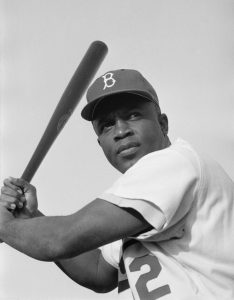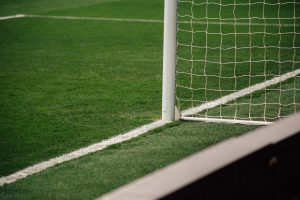The day in the life of a multisport athlete is busier than most.
For Roosevelt University junior Elaina Feuerbach it begins at 7 a.m., when she wakes up for track practice, and it usually ends somewhere around midnight — after another track practice, soccer practice, classes, homework and volunteering as a tutor at a local shelter.
Feuerbach isn’t alone.

Fellow Lakers athlete Jake Cigelnik plays soccer and tennis and lives the double-life of a dual-sport athlete as well. Like Feuerbach, Cigelnik has finished half his day before most students even wake up.
There was a time where multisport athletes like this were lauded for their dedication, but they are becoming a rare — and some may say, “dying” — breed among 21st-century athletes because of the increase in single-sport players.
With fewer multisport athletes, the days of competitors like Bo Jackson, Randy Johnson and Steve Nash could be gone. And the days of single-sport players with shorter careers could be the future.
The more specialized athletes become in one sport, the more travel teams, elite clubs, youth organizations and community leagues pop up. The result: more and more children at younger and younger ages are not only starting to play sports, but are also feeling the pressure to play at a high level and pick one sport they think they’ll be the best at to focus on for the rest of their lives.
In the United States, 77.7 percent of high school athletic directors reported an increase in sport specialization. Yet, less than 1 percent of youth athletes, ages 6 to 17, reach a professional level, according to a Loyola Stritch School of Medicine study.
While some think specialization and intense training will lead to an elite level in a shorter time frame, for most sports there is no evidence that this is necessary. However, there is proof that sport specialization leads to a higher risk of injury, increased psychological stress and burnout, according to the Loyola study.
The ongoing study of youth athletes, 8- to 18-years old, reported that 38 percent quit another sport to specialize in one. Of the remaining multisport athletes, 32 percent said they spent more than three quarters of their training time focused in one sport.
With the demands to play one sport year round, Roosevelt’s Feuerbach said the underlying appreciation and passion for sports decreases as a result.
“I don’t think kids really have the chance to miss it if they are in it all the time,” Feuerbach said. “They don’t learn to love it, instead they just learn that it’s an everyday thing, which is upsetting.”
In addition, Loyola’s study showed one out of five specialized athletes reported injury as the reason for quitting the sport — something seen first-hand by Tim Rylander, physical therapist and head of concussion rehab at Accelerated Rehabilitation Centers.
“The one thing that we’ve noticed consistently across the board is that we’ve seen individuals, particularly children, sustaining injuries at an earlier and earlier age, primarily overuse injuries,” Rylander said. “This really wasn’t a problem years ago.”
Rylander said that single-sport athletes today are playing that sport all year round, which can cause serious damage at a much earlier time in their careers.
“For a lot of these athletes, there’s hardly an offseason,” Rylander said. “We’re seeing injuries that we didn’t use to see until individuals were in the 30s and 40s, and now we’re seeing it in their teen years.”
He added that those who have faulty or bad habits in their chosen sport tend to speed up the break down process and increase their risk of injury. Single-sport athletes are not giving their bodies a chance to have varying movement patterns or cross training that multisport athletes do.
Rylander said specialization stems deeper than the physical ailments that can occur.
“Beyond the physical aspect of it, there’s a huge psychological aspect that carries with it too,” he said. “We’re seeing a lot of burnout and a lot of psychological stress in individuals.”
In addition to the physical and mental tolls specialization has on athletes, Rylander said another burnout factor is the pressure to perform at a high level, which is not only existent in high school, but has expanded into the middle school and youth levels as well.
“I definitely think that the fun aspect of organized sports has started to take a back seat,” Rylander said. “I see kids coming into high school who are just worn. They’re just worn out.”

As an athlete who experienced burnout twice during his career, Roosevelt’s Cigelnik, said sometimes you have to leave to realize how much you miss that sport. But for those who specialize in one sport year round, there might not be a return.
“There are times where I wished I played one sport,” Cigelnik said. “But if you pick the wrong sport, then you’ll never know what other sport you would’ve played and you’ll get burned out of it.”
Brian Watkins, program director of i9 Sports of Chicago’s North Side, said the encouragement of multisport athletes and the use of athletics in character building is not only something i9 Sports is centered around, but is also something he stresses to his fifth-grade students.
“You can tell there are those skills — social skills and personality skills — that sports definitely bring out of the kids,” Watkins said. He added that those athletes are more comfortable around other people and with handling daily challenges.
i9 Sports, which is based in Tampa, Florida, is the nation’s first and largest youth sports league nationwide — more than 600,000 members across 500 communities from New York to Hawaii. The organization says it focuses on fun, safety, convenience and good sportsmanship for athletes, ages 3 to 17.
Watkins said he thinks the majority of people still want their children to explore multiple sports because of the range of offered sports and rapid growth i9 Sports has seen nationwide.

Watkins said as the hype and media coverage of professional and high-level collegiate athletes grow, the further away the sports industry gets from the initial reason children go out for sports in the first place: camaraderie, fun and friendships.
Instead of learning how hard work helps overcome adversity and creates confidence, younger and younger athletes are focused on not being “good enough” if they don’t start playing early and all year round. That not only deters kids from initially playing, but also leads to burnout, Watkins said.
Corey Brown, a former Division III four-time All-American wrestler from Thiel College in Greenville, Pennsylvania, said that although he still has moments where he wonders how his career could have been different had he not played football in his middle and high school years, he also thinks specializing in only wrestling would have made burnout and injury harder to avoid.
“Looking back, I gained a lot from football, but think I would’ve been an even better wrestler if I didn’t play football,” Brown said. “If I would’ve kept the same motivation level that I had, and had I wrestled everyday for 12 years, I think I would’ve been a national champion with that extra invested time … but throwing in those unknown variables of potential injury and then potentially being burned out, I don’t know if I would’ve even reached what I did to get here.”
While Brown said his in-season and offseason wrestling training increased once he got to college, he said regardless of whether the athlete is a multisport or specialized in one, there has to be time off to recover physically and mentally.
Brown not only has mixed feelings on his own career, but also he said he has various thoughts on whether he would push his future children to be single-sport athletes because of how much the pressure to perform has increased at younger ages compared to when he played.

“I remember it was fun for me when I played when I was that young because you think it’s fun and you enjoy it, you’re less stressed,” Brown said. “I just know as soon as I got to high school … it was like ‘fun time is over;’ but I was a freshman in high school, not fifth grade.”
While the Loyola study reported that parents were the strongest influence for athletes to initially play sports, outside factors such as social media, coaches, college scholarships and the dream to play professionally lead to the debate on whether specialized athletes will dominate, and the days of Bo Jackson are far behind.
“I think we’re fighting an uphill battle on this one,” Brown said. “Back in the day [Bo Jackson] could do that … but there’s no way he could do it today because of the level of competition. That’s because of single-sport athletes. Everyone’s so specialized now that it’s one thing to do them, if you’re even allowed to do them, but to excel in both of them, it’s going to become more and more of a rarity.”
As a physical therapist, Rylander stands behind the medical reports that show there is no evidence that specialization is needed to reach an elite playing level.

“I don’t think sports specialization is needed to enhance performance, but there’s this perception that it is,” Rylander said. “From a biomechanical point of view, cross training and participating in multiple sports enhances athleticism, and can actually, in my opinion, further progress their primary sport while reducing their injury risk.”
As a parent and former athlete, i9 Sports’ Watkins said he thinks the turn back to a multi-sport-focused society will be tough, but is something that will happen because parents will not want their children to experience the heightened pressure, but instead have fun and explore a variety of sports to find where their passions lie.
Whether specialization is here to stay or the constant “uphill battle” as Brown said, Roosevelt’s Feuerbach said the main point to remember is that whether it’s a multisport or single sport athlete, it should be the choice of that athlete to decide at any point in their career where their passion lies and where they want to devote their playing time.
Although it’s cliché, Feuerbach said regardless of how many sports you play, the amount of time spent training, the money, the pressure or the questions you receive throughout your athletic career, to always remember to play “for the love of the game.”










Be First to Comment